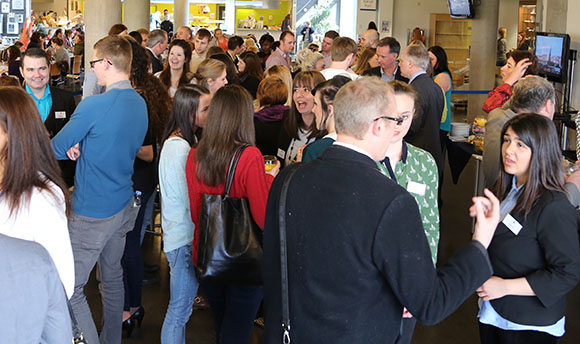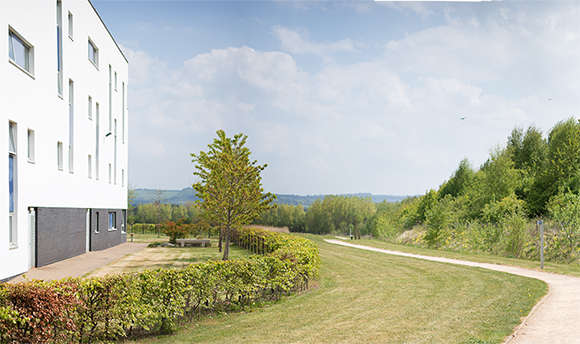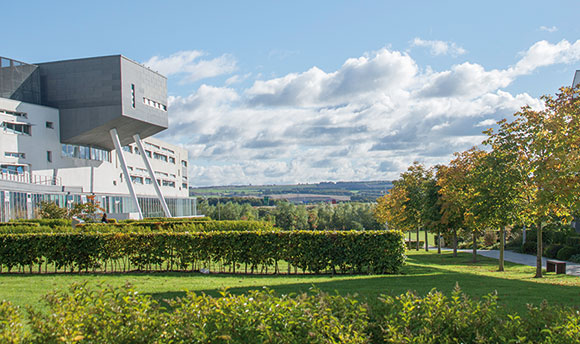Pioneering speech technology transforms girl born deaf into confident speaking law student
A girl who was born deaf and spent the first three years of her life with no hearing has had her life transformed by pioneering speech technology. Thanks, in part, to speech experts at Queen Margaret University (QMU), Edinburgh, Lily Davidson’s life has dramatically changed from a baby who was unable to hear or talk, to a confident young speaker who is studying law at university.
Lily, from Loanhead in Midlothian, was born deaf, but she was suitable for a cochlear implant, which was fitted at three years old. While a cochlear implant cannot return hearing to normal, its electrical impulses stimulate nerves, and wearers hear modified sounds, including the sounds of speech. This makes it possible to learn to speak, but a late start and limited hearing make it harder to learn.
After much work with audiologists and speech and language therapists (SLTs), she had made excellent progress, but she still struggled to speak certain sounds clearly. Her family were concerned this could affect her social life as well as her future career prospects, issues known to affect young people with speech difficulties. Some specific sounds remained particularly frustrating and difficult for Lily. For example, problems producing the sound ‘L’ clearly meant she was anxious every time she had to pronounce her own name.
Lily started working with Dr Sara Wood, a clinical phonetics researcher and SLT at Queen Margaret University, shortly after receiving a second cochlear implant. Dr Wood began using a pioneering new technology called electropalatography with Lily to help improve her speech intelligibility.
Electropalatography (EPG) is a technique developed by speech experts at QMU which records where and when the tongue makes contact with the roof of the mouth during speech. It can be a particularly useful means of helping some children with speech difficulties to improve their speech because it provides visual feedback to the child, which is not ordinarily available, and does not rely purely on what the child hears.
Lily was fitted with an artificial palate, which is used in the pioneering EPG therapy. It takes the form of a dental plate which is custom made for the client (child or adult). The client wears the palate, which contains 62 electrodes that detect the client’s tongue movement on the roof of the mouth when they speak. These can be analysed and compared to typical speech patterns to help the speech and language therapist identify, more accurately, errors in the client’s speech. During a session, the therapist also wears a customised palate and models the correct patterns to the client. The client can clearly see the images that the tongue makes on the computer screen. The client tries to copy the therapist’s tongue movements by trying to recreate the same pattern which shows on the computer screen, and the therapist is able to use the visualisation to accurately guide the improving speech articulations.
The pioneering technique is used to assess and classify disordered speech patterns as well as helping to resolve errors. This is how it lets the SLT help children with severe and persistent speech disorders to develop more accurate speech sound productions, leading to greater more confident .
James Scobbie, Professor of Speech Sciences at QMU, explained: “Lily was able to use EPG to literally see where she are going wrong inside her mouth during speech. Rather than having to rely on her auditory skills where she would just listen and repeat what her speech therapist said, she could see for the first time what her tongue was doing inside her mouth. The visual feedback on the computer helped to show her exactly where her tongue was in comparison to where it should be positioned to achieve the correct speech sound.”
Lily said: “I didn’t realise what I was doing wrong before but seeing the shapes my tongue made on a computer screen made it easy for me to learn how to change my words. Also, working on a computer and seeing the images was much more fun than just repeating the words over and over again.”
Lily was the first person with a cochlear implant to receive EPG therapy at QMU. It significantly helped her improve the production of “L” and some other speech sounds. However, she still had difficulty with the pronunciation of the sound ‘R’.
By positioning an ultrasound probe under his chin, Professor Scobbie was able to show Lily how to produce the ‘R’ sound by having her watch images of his tongue moving in real time. In turn, she then watched her own tongue moving inside her mouth during speech. She was able to copy what she saw in the ultrasound image and reproduce it correctly. It only took one ultrasound session for Lily to get it right!
“Most people trying to correct speech problems have to rely on auditory feedback alone”, said Professor Scobbie. “However, as soon as Lily had the opportunity to use two types of visual feedback, these last, difficult speech sounds improved dramatically. She suddenly was sure how it felt to articulate these sounds correctly.”
These noticeable aspects of Lily’s speech were greatly improved with the University’s EPG and ultrasound technologies. Her mother, Carolyn, said: "Not only had the clarity of her words improved, she gained a huge boost to her confidence, especially when meeting new people. It helped her socially and academically and she was able to fulfil her ambition when she secured a place at Aberdeen University to study Law with European Studies.
Lily, who is now 22 years of age, explained: “I am often complimented on how well enunciated my speech is for an individual with hearing loss. My speech improvement has given me the confidence to speak in front of a wide variety of groups such as at Model United National conferences across the country, as well as oral assessments, advocacy assessments and group presentations as part of my degree. My success in using EPG has impacted in all areas of my life.”
EPG therapy is not routinely available on the NHS, but Queen Margaret University is now providing specialist speech therapy using its pioneering technologies to more children thanks to charitable support for the new Wooden Spoon Speech Clinic based at Queen Margaret University.
Patients can self refer to refer via a doctor. Contact WoodenSpoonSpeechClinic@qmu.ac.uk for further information.
For further media information please contact Lynne Russell, Communications Manager at Queen Margaret University, Edinburgh, E: lrussell@qmu.ac.uk T: 0131 474 0000.



